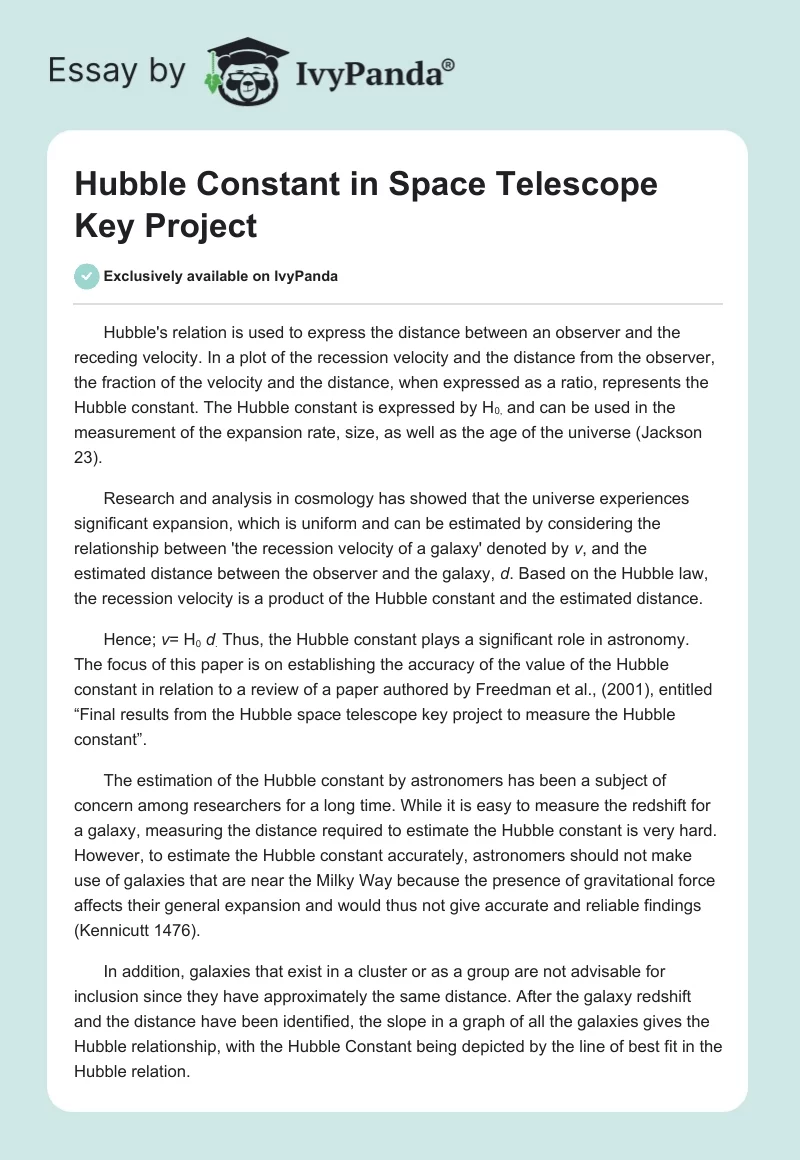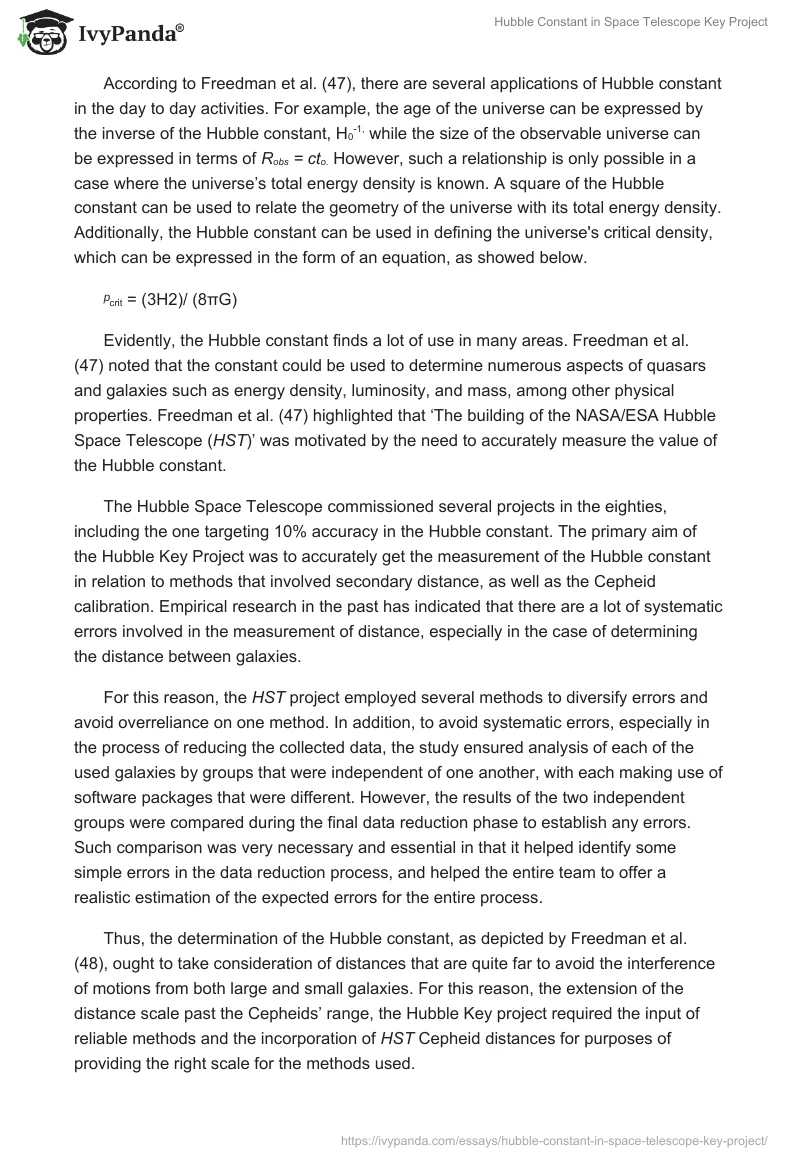Hubble’s relation is used to express the distance between an observer and the receding velocity. In a plot of the recession velocity and the distance from the observer, the fraction of the velocity and the distance, when expressed as a ratio, represents the Hubble constant. The Hubble constant is expressed by H0, and can be used in the measurement of the expansion rate, size, as well as the age of the universe (Jackson 23).
Research and analysis in cosmology has showed that the universe experiences significant expansion, which is uniform and can be estimated by considering the relationship between ‘the recession velocity of a galaxy’ denoted by v, and the estimated distance between the observer and the galaxy, d. Based on the Hubble law, the recession velocity is a product of the Hubble constant and the estimated distance.
Hence; v= H0 d. Thus, the Hubble constant plays a significant role in astronomy. The focus of this paper is on establishing the accuracy of the value of the Hubble constant in relation to a review of a paper authored by Freedman et al., (2001), entitled “Final results from the Hubble space telescope key project to measure the Hubble constant”.
The estimation of the Hubble constant by astronomers has been a subject of concern among researchers for a long time. While it is easy to measure the redshift for a galaxy, measuring the distance required to estimate the Hubble constant is very hard. However, to estimate the Hubble constant accurately, astronomers should not make use of galaxies that are near the Milky Way because the presence of gravitational force affects their general expansion and would thus not give accurate and reliable findings (Kennicutt 1476).
In addition, galaxies that exist in a cluster or as a group are not advisable for inclusion since they have approximately the same distance. After the galaxy redshift and the distance have been identified, the slope in a graph of all the galaxies gives the Hubble relationship, with the Hubble Constant being depicted by the line of best fit in the Hubble relation.
According to Freedman et al. (47), there are several applications of Hubble constant in the day to day activities. For example, the age of the universe can be expressed by the inverse of the Hubble constant, H0-1, while the size of the observable universe can be expressed in terms of Robs = cto. However, such a relationship is only possible in a case where the universe’s total energy density is known. A square of the Hubble constant can be used to relate the geometry of the universe with its total energy density. Additionally, the Hubble constant can be used in defining the universe’s critical density, which can be expressed in the form of an equation, as showed below.
ᵖcrit = (3H2)/ (8πG)
Evidently, the Hubble constant finds a lot of use in many areas. Freedman et al. (47) noted that the constant could be used to determine numerous aspects of quasars and galaxies such as energy density, luminosity, and mass, among other physical properties. Freedman et al. (47) highlighted that ‘The building of the NASA/ESA Hubble Space Telescope (HST)’ was motivated by the need to accurately measure the value of the Hubble constant.
The Hubble Space Telescope commissioned several projects in the eighties, including the one targeting 10% accuracy in the Hubble constant. The primary aim of the Hubble Key Project was to accurately get the measurement of the Hubble constant in relation to methods that involved secondary distance, as well as the Cepheid calibration. Empirical research in the past has indicated that there are a lot of systematic errors involved in the measurement of distance, especially in the case of determining the distance between galaxies.
For this reason, the HST project employed several methods to diversify errors and avoid overreliance on one method. In addition, to avoid systematic errors, especially in the process of reducing the collected data, the study ensured analysis of each of the used galaxies by groups that were independent of one another, with each making use of software packages that were different. However, the results of the two independent groups were compared during the final data reduction phase to establish any errors. Such comparison was very necessary and essential in that it helped identify some simple errors in the data reduction process, and helped the entire team to offer a realistic estimation of the expected errors for the entire process.
Thus, the determination of the Hubble constant, as depicted by Freedman et al. (48), ought to take consideration of distances that are quite far to avoid the interference of motions from both large and small galaxies. For this reason, the extension of the distance scale past the Cepheids’ range, the Hubble Key project required the input of reliable methods and the incorporation of HST Cepheid distances for purposes of providing the right scale for the methods used.
In the case of this study, there was a need to make use of HST in the process of accurately determining the Hubble constant. The HST was necessary because HST provided the opportunity to offer images that were of high quality and essentially non-varying. In addition, the HST has a special capacity such that one can schedule it optimally to ensure that the Cepheid variables used in the study are discovered (Hynecek 39). As such, HST is suitable in such studies since one can make observations without relying on the weather, time of the day, or even the moon.
To accurately determine the distances involved in the HST project, absolute photometric calibration was necessary (Freedman et al. 48). However, the process of determining accurate Cepheid magnitude was one of the potential sources of uncertainty in the Hubble constant. This also has a significant effect on the zero-point calibration. Thus, to overcome such challenges, the Key Project adopted independent calibration. These ensured that there were no cases of errors in the calibration process and that the exact readings could be obtained effectively.
From the above analysis, it was evident that the Hubble constant is a very important element in the cosmology and astronomy fields. In spite of this, accurate measurement of the Hubble constant remains to be a challenge, especially when considering the difficulties involved in determining the recession velocity of a particular galaxy and the distance required to make an estimation of the Hubble constant (Nota 31). Nonetheless, the HST Key project was very successful in measuring the Hubble constant, which was only successful after the incorporation of numerous alternative methods. Based on the measurements and precautions taken in the Key Project, it can be considered that the measurement of the Hubble Constant was accurate.
Works Cited
Freedman, Wendy, Madore F. Barry, Gibson K. Brad, Ferrarese Laura, Kelson Daniel, Sakai Shoko, Mould R. Jeremy, Kennicutt C. Robert, Ford C. Holland, Graham A. John, Huchra P. John, Hughes G. Shaum, Illingworth D. Garth, Macri M. Lucas, and Stetson B. Peter. “Final results from the Hubble space telescope key project to measure the Hubble constant”. ApJ 553.1 (2001): 47-72. Print.
Hynecek, Jaroslav. “Is The Hubble Constant The Same Everywhere In The Universe?”. Applied Physics Research 7.3 (2015): 21-39. Print.
Jackson, Neal. “The Hubble Constant”. Living Reviews in Relativity 10 (2007): 2-23. Print.
Kennicutt, Robert. “Measuring The Hubble Constant With The Hubble Space Telescope”. The Astronomical Journal 110 (2005): 1476. Print.
Nota, Siriani. “Discovery of a Population of Pre-Main-Sequence Stars in NGC 346 From Deep Hubble Space Telescope ACS Images”. ApJ 640.1 (2006): 29-33. Print.


